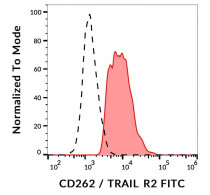ARG53806
anti-CD262 / TRAIL R2 antibody [DR5-01-1] (FITC)
anti-CD262 / TRAIL R2 antibody [DR5-01-1] (FITC) for Flow cytometry and Human
Cancer antibody; Cell Biology and Cellular Response antibody; Cell Death antibody; Signaling Transduction antibody
Overview
| Product Description | FITC-conjugated Mouse Monoclonal antibody [DR5-01-1] recognizes CD262 / TRAIL R2 |
|---|---|
| Tested Reactivity | Hu |
| Tested Application | FACS |
| Specificity | The clone DR5-01-1 recognizes an extracellular domain of TRAIL-R2 (DR5). TRAIL-R2 is one of two TNF superfamily member intracellular death domain containing receptors for TRAIL (APO2L). |
| Host | Mouse |
| Clonality | Monoclonal |
| Clone | DR5-01-1 |
| Isotype | IgG1 |
| Target Name | CD262 / TRAIL R2 |
| Antigen Species | Human |
| Immunogen | Recombinant fusion protein of human IgG heavy chain and extracellular domain of DR5. |
| Conjugation | FITC |
| Alternate Names | TRICK2A; TRICK2B; KILLER; TRAILR2; TNF-related apoptosis-inducing ligand receptor 2; DR5; CD antigen CD262; TRICK2; CD262; KILLER/DR5; Tumor necrosis factor receptor superfamily member 10B; Death receptor 5; TRAIL-R2; TRAIL receptor 2; TRICKB; ZTNFR9 |
Application Instructions
| Application Suggestion |
|
||||
|---|---|---|---|---|---|
| Application Note | * The dilutions indicate recommended starting dilutions and the optimal dilutions or concentrations should be determined by the scientist. |
Properties
| Form | Liquid |
|---|---|
| Purification Note | The purified antibody is conjugated with Fluorescein isothiocyanate (FITC) under optimum conditions. The reagent is free of unconjugated FITC. |
| Buffer | PBS, 15 mM Sodium azide and 0.2% (w/v) high-grade protease free BSA |
| Preservative | 15 mM Sodium azide |
| Stabilizer | 0.2% (w/v) high-grade protease free BSA |
| Concentration | 0.1 mg/ml |
| Storage Instruction | Aliquot and store in the dark at 2-8°C. Keep protected from prolonged exposure to light. Avoid repeated freeze/thaw cycles. Suggest spin the vial prior to opening. The antibody solution should be gently mixed before use. |
| Note | For laboratory research only, not for drug, diagnostic or other use. |
Bioinformation
| Database Links |
Swiss-port # O14763 Human Tumor necrosis factor receptor superfamily member 10B |
|---|---|
| Gene Symbol | TNFRSF10B |
| Gene Full Name | tumor necrosis factor receptor superfamily, member 10b |
| Background | TRAIL-R2 (CD262, DR5) is one of two TNF superfamily member intracellular death domain containing receptors for TRAIL (APO2L). Apoptosis, or programmed cell death, occurs during normal cellular differentiation and development of multicellular organisms. Apoptosis is induced by certain cytokines including tumor necrosis factor (TNF) and Fas ligand in the TNF family through their death domain containing receptors, TNF receptor 1 (TNFR1) and Fas, respectively. Another member in the TNF family has been identified and designated TRAIL (for TNF related apoptosis inducing ligand) and Apo2L (for Apo2 ligand). Receptors for TRAIL include two death domain containing receptors, DR4 and DR5, as well as two decoy receptors, DcR1 and DcR2, lacking the intracellular signaling death domain. DcR1 (also called TRID), like the related death receptors DR4 and DR5, contains two extracellular cysteine rich domains. However, DcR1 contains no intracellular death domain and is thus incapable of signaling apoptosis. It has been suggested DcR1 is responsible for TRAIL resistance in normal human tissues including heart, placenta, lung, liver, kidney, spleen, and bone marrow. DR5 is a member of the TNF receptor superfamily, and contains an intracellular death domain. This receptor can be activated by tumor necrosis factor related apoptosis inducing ligand (TNFSF10/TRAIL/APO2L), and transduces apoptosis signal. Studies with FADD deficient mice suggested that FADD, a death domain containing adaptor protein, is required for the apoptosis mediated by this protein. |
| Function | Receptor for the cytotoxic ligand TNFSF10/TRAIL. The adapter molecule FADD recruits caspase-8 to the activated receptor. The resulting death-inducing signaling complex (DISC) performs caspase-8 proteolytic activation which initiates the subsequent cascade of caspases (aspartate-specific cysteine proteases) mediating apoptosis. Promotes the activation of NF-kappa-B. Essential for ER stress-induced apoptosis. [UniProt] |
| Research Area | Cancer antibody; Cell Biology and Cellular Response antibody; Cell Death antibody; Signaling Transduction antibody |
| Calculated MW | 48 kDa |
Images (1) Click the Picture to Zoom In








